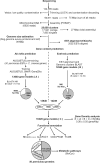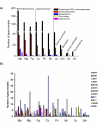A genome survey of Moniliophthora perniciosa gives new insights into Witches' Broom Disease of cacao
- PMID: 19019209
- PMCID: PMC2644716
- DOI: 10.1186/1471-2164-9-548
A genome survey of Moniliophthora perniciosa gives new insights into Witches' Broom Disease of cacao
Abstract
Background: The basidiomycete fungus Moniliophthora perniciosa is the causal agent of Witches' Broom Disease (WBD) in cacao (Theobroma cacao). It is a hemibiotrophic pathogen that colonizes the apoplast of cacao's meristematic tissues as a biotrophic pathogen, switching to a saprotrophic lifestyle during later stages of infection. M. perniciosa, together with the related species M. roreri, are pathogens of aerial parts of the plant, an uncommon characteristic in the order Agaricales. A genome survey (1.9x coverage) of M. perniciosa was analyzed to evaluate the overall gene content of this phytopathogen.
Results: Genes encoding proteins involved in retrotransposition, reactive oxygen species (ROS) resistance, drug efflux transport and cell wall degradation were identified. The great number of genes encoding cytochrome P450 monooxygenases (1.15% of gene models) indicates that M. perniciosa has a great potential for detoxification, production of toxins and hormones; which may confer a high adaptive ability to the fungus. We have also discovered new genes encoding putative secreted polypeptides rich in cysteine, as well as genes related to methylotrophy and plant hormone biosynthesis (gibberellin and auxin). Analysis of gene families indicated that M. perniciosa have similar amounts of carboxylesterases and repertoires of plant cell wall degrading enzymes as other hemibiotrophic fungi. In addition, an approach for normalization of gene family data using incomplete genome data was developed and applied in M. perniciosa genome survey.
Conclusion: This genome survey gives an overview of the M. perniciosa genome, and reveals that a significant portion is involved in stress adaptation and plant necrosis, two necessary characteristics for a hemibiotrophic fungus to fulfill its infection cycle. Our analysis provides new evidence revealing potential adaptive traits that may play major roles in the mechanisms of pathogenicity in the M. perniciosa/cacao pathosystem.
Figures







Similar articles
-
Genome sequence and effectorome of Moniliophthora perniciosa and Moniliophthora roreri subpopulations.BMC Genomics. 2018 Jul 3;19(1):509. doi: 10.1186/s12864-018-4875-7. BMC Genomics. 2018. PMID: 29969982 Free PMC article.
-
Identification of a second family of genes in Moniliophthora perniciosa, the causal agent of witches' broom disease in cacao, encoding necrosis-inducing proteins similar to cerato-platanins.Mycol Res. 2009 Jan;113(Pt 1):61-72. doi: 10.1016/j.mycres.2008.08.004. Epub 2008 Aug 30. Mycol Res. 2009. PMID: 18796332
-
Moniliophthora perniciosa, the causal agent of witches' broom disease of cacao: what's new from this old foe?Mol Plant Pathol. 2008 Sep;9(5):577-88. doi: 10.1111/j.1364-3703.2008.00496.x. Mol Plant Pathol. 2008. PMID: 19018989 Free PMC article. Review.
-
Genomic analyses and expression evaluation of thaumatin-like gene family in the cacao fungal pathogen Moniliophthora perniciosa.Biochem Biophys Res Commun. 2015 Oct 30;466(4):629-36. doi: 10.1016/j.bbrc.2015.09.054. Epub 2015 Sep 11. Biochem Biophys Res Commun. 2015. PMID: 26367180
-
Chocolate Under Threat from Old and New Cacao Diseases.Phytopathology. 2019 Aug;109(8):1331-1343. doi: 10.1094/PHYTO-12-18-0477-RVW. Epub 2019 Jul 1. Phytopathology. 2019. PMID: 31115251 Review.
Cited by
-
Global transcriptional analysis suggests Lasiodiplodia theobromae pathogenicity factors involved in modulation of grapevine defensive response.BMC Genomics. 2016 Aug 11;17(1):615. doi: 10.1186/s12864-016-2952-3. BMC Genomics. 2016. PMID: 27514986 Free PMC article.
-
Molecular and functional evolution of the fungal diterpene synthase genes.BMC Microbiol. 2015 Oct 19;15:221. doi: 10.1186/s12866-015-0564-8. BMC Microbiol. 2015. PMID: 26483054 Free PMC article.
-
Lentinula edodes Genome Survey and Postharvest Transcriptome Analysis.Appl Environ Microbiol. 2017 May 1;83(10):e02990-16. doi: 10.1128/AEM.02990-16. Print 2017 May 15. Appl Environ Microbiol. 2017. PMID: 28314725 Free PMC article.
-
The good, the bad and the tasty: The many roles of mushrooms.Stud Mycol. 2016 Sep;85:125-157. doi: 10.1016/j.simyco.2016.11.002. Epub 2016 Nov 11. Stud Mycol. 2016. PMID: 28082758 Free PMC article.
-
Identification and characterization of a class III chitin synthase gene of Moniliophthora perniciosa, the fungus that causes witches' broom disease of cacao.J Microbiol. 2009 Aug;47(4):431-40. doi: 10.1007/s12275-008-0166-3. Epub 2009 Sep 9. J Microbiol. 2009. PMID: 19763417
References
-
- Griffith GW, Nicholson J, Nenninger A, Birch RN, Hedger JN. Witches' brooms and frosty pods: two major pathogens of cacao. New Zeal J Bot. 2003;41:423–435.
-
- Pereira JL, Ram A, Figuereido JM, de Almeida LC. La primera aparición de la "escoba de bruja" en la principal área productora de cacao del Brasil. Turrialba. 1989;39:459–461.
Publication types
MeSH terms
Substances
LinkOut - more resources
Full Text Sources
Other Literature Sources
Molecular Biology Databases

